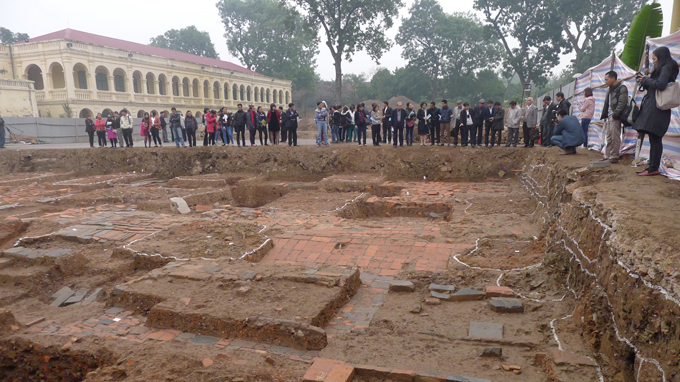Experts at a recent workshop, held to report the results of the excavation at the UNESCO-recognized Thang Long Imperial Citadel in Hanoi, estimated that it would take 1-2 centuries to explore the complex in depth.
The excavation, which kicked off in 2008, has begun to reveal a considerably larger area, which in experts’ estimation would measure several hectares, compared to the unearthed area of some thousands of square meters.
“Our current knowledge about the site is nothing compared to the entire treasure it boasts. It would probably take one or two centuries to explore the entire complex, and 50-60 years just to delve into its core quarter alone,” Ass. Prof Tong Trung Tin noted.
The experts strongly urged that short-term and long-term planning be made for the complex and a continuous, painstaking research process be initiated on the site.
According to the Vietnam Archeology Institute, the excavator, the excavation established the continual cultural strata spanning from Dai La, the country’s capital in the 8th and 9th centuries to the Ly, Tran, Le and Nguyen dynasties.
The excavation also, for the first time ever, disclosed the vestige of the buttresses and a brick-tiled yard in the Ly dynasty (1009-1225) and a huge sewage in the Tran dynasty (1225-1400). A large phoenix statue and other prized artifacts are also indicative of the dynasties’ architecture which thrived at the site, Tin pointed out.
The findings at the excavation areas within the Thang Long Imperial Citadel in 2012 and 2013 have cemented a Japanese professor’s belief that the complex boasts Asia’s best preserved underground architecture.
However, the Vietnam Archeology Institute stressed that lots of mysteries about the complex, such as the layouts of the Ly and Tran dynasties’ architecture, are awaiting revelation.
Dr. Nguyen Van Son, head of the Thang Long - Hanoi Heritage Preservation Center, also urged that all the materials and artifacts unearthed at several sections of the complex be handed over to the center soon.
The Thang Long Imperial Citadel, one of the country’s momentous relics, was initially built during the Ly Dynasty and subsequently expanded by the Tran, Le and Nguyen Dynasties. The central area of the imperial citadel was listed as a UNESCO's World Heritage Site in 2010.
The royal palaces and most of the structures in the complex were in deteriorating conditions by the late 19th and 20th centuries. Only in the 21st century did systematic excavations begin on its ruined foundations. The first remains were unearthed on the site of the former Ba Dinh Hall or the old National Assembly Building which was demolished in 2008 to make room for a new parliament building.




















































